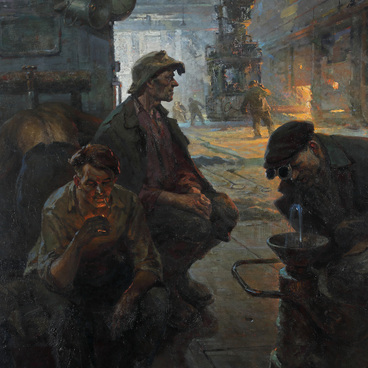This portrait of professor Stanislav Semyonovich Shwarts was painted by the Sverdlovsk artist Pavel Voinkov in 1966.
The painter depicted a famous Ural scientist, theorist, and practitioner sitting at the table in his office and laboratory. In front of him on a blue cloth, there are prototypes, reams of paper, and two inkwells, and behind the biologist’s back is a microscope and laboratory glassware. With his brush, Voinkov managed to create a portrait that reflected the essence of a true science enthusiast, whose research activity from 1946 until the end of his life was associated with Sverdlovsk.
The demand for a portrait of Stanislav Schwartz can be explained by the importance of ecology at the time. As a separate discipline, it originated at the turn of the 20th century, but it was in the 1960s (around the time when the painting was created) that ecology became widely distributed and recognized in Russia. All that was achieved thanks to Schwartz’s enormous contribution and efforts.
Stanislav Schwartz was a famous Soviet and Russian scientist, zoologist, and ecologist, who had a doctorate degree in biological sciences. For over twenty years, he headed the Institute of Biology of the Ural Branch of the USSR Academy of Sciences, transforming it into the Institute of Plant and Animal Ecology. For a long time, the scientist supervised the studies of the Far North nature. As the founder of the Ural scientific school in the field of population and evolutionary ecology, Stanislav Semyonovich Schwartz repeatedly represented Soviet ecology at international congresses, conventions, symposiums, and conferences.
The scientist was known and respected all over the world. In 1971, he was elected chairman of the International Commission for the Study of Tundra. He was also a member of the International Academy of Zoology in Agra (India) and a member of the International Association for Ecology.
Among other things, Schwartz was the editor-in-chief of the “Ecology” magazine from its establishment until the last days of his life. The magazine was the first ecology-related publication in the USSR.
The same year as the portrait was created, Stanislav Schwartz became a corresponding member of the USSR Academy of Sciences, and a little later, was made a full member of the Academy.
The scientist’s achievements were properly distinguished by the state: he was awarded the Order of Lenin and the Order of the October Revolution, and one of the streets of Yekaterinburg was named after him.
The painter depicted a famous Ural scientist, theorist, and practitioner sitting at the table in his office and laboratory. In front of him on a blue cloth, there are prototypes, reams of paper, and two inkwells, and behind the biologist’s back is a microscope and laboratory glassware. With his brush, Voinkov managed to create a portrait that reflected the essence of a true science enthusiast, whose research activity from 1946 until the end of his life was associated with Sverdlovsk.
The demand for a portrait of Stanislav Schwartz can be explained by the importance of ecology at the time. As a separate discipline, it originated at the turn of the 20th century, but it was in the 1960s (around the time when the painting was created) that ecology became widely distributed and recognized in Russia. All that was achieved thanks to Schwartz’s enormous contribution and efforts.
Stanislav Schwartz was a famous Soviet and Russian scientist, zoologist, and ecologist, who had a doctorate degree in biological sciences. For over twenty years, he headed the Institute of Biology of the Ural Branch of the USSR Academy of Sciences, transforming it into the Institute of Plant and Animal Ecology. For a long time, the scientist supervised the studies of the Far North nature. As the founder of the Ural scientific school in the field of population and evolutionary ecology, Stanislav Semyonovich Schwartz repeatedly represented Soviet ecology at international congresses, conventions, symposiums, and conferences.
The scientist was known and respected all over the world. In 1971, he was elected chairman of the International Commission for the Study of Tundra. He was also a member of the International Academy of Zoology in Agra (India) and a member of the International Association for Ecology.
Among other things, Schwartz was the editor-in-chief of the “Ecology” magazine from its establishment until the last days of his life. The magazine was the first ecology-related publication in the USSR.
The same year as the portrait was created, Stanislav Schwartz became a corresponding member of the USSR Academy of Sciences, and a little later, was made a full member of the Academy.
The scientist’s achievements were properly distinguished by the state: he was awarded the Order of Lenin and the Order of the October Revolution, and one of the streets of Yekaterinburg was named after him.

